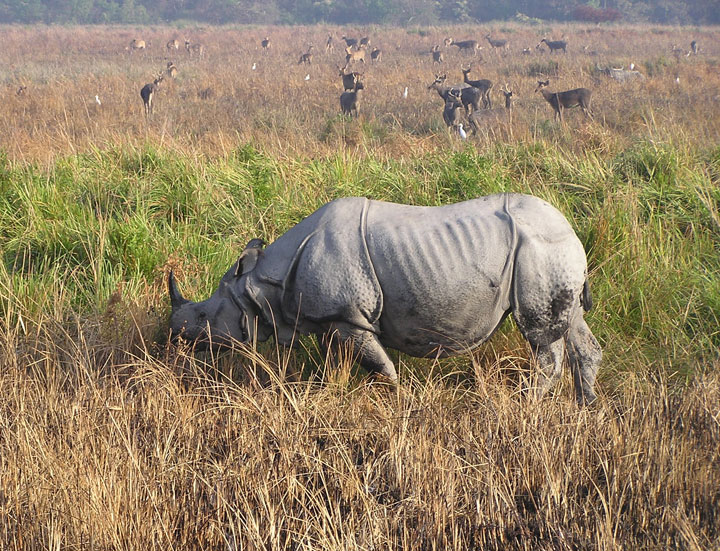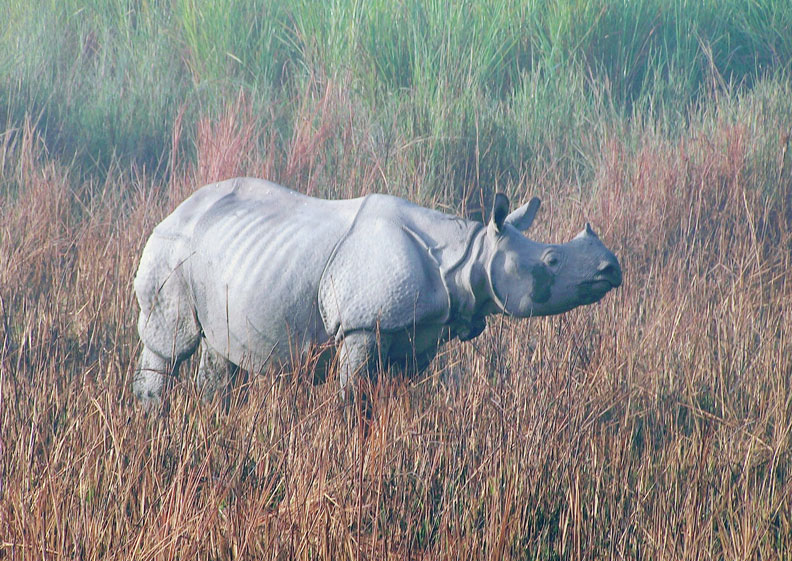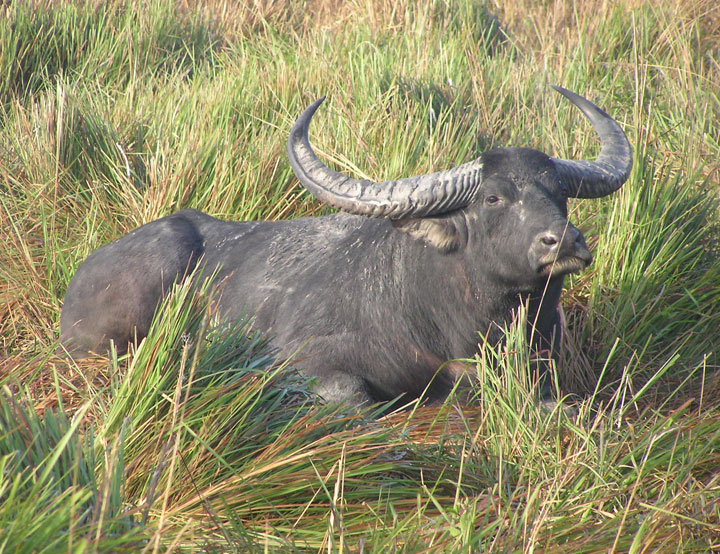
Rhinos share India’s Kaziranga Wildlife Preserve with many other animals. Photo by Jacqueline Swartz
Driving slowly down the narrow road bordering the Kaziranga Wildlife Preserve in north eastern India, my guide promised me a rhino sighting early the following morning. Elephants, endangered Wild Buffalo and deer roam this area, 25 miles long and eight miles wide, marked by tall grasses, marshes and the mighty Brahmaputra river. But the prize sight is the rare Indian one-horned rhino, brought back from near extinction in the last century.
The rhino is formally called rhinoceros unicornis, and there are some interesting links to the fabled white unicorn. The one-horned animal was first depicted in the earliest Mesopotamian pictorial art thousands of years ago. It was referred to in myths from India and China.
When Marco Polo, the famous 13th century Venetian traveler, visited Asia and wrote about the unicorn, he was probably referring to the Indian rhinoceros. At that time, they roamed freely from Northern Pakistan to the Myanmar border, and in parts of Nepal and Bangladesh.
By the early 1900’s they were almost driven to extinction by sport hunters and farmers who regarded the rhino as pests. But thanks to the Kaziranga Wildlife Preserve, the Indian rhino made a comeback in the last century. The Preserve, now a UNESCO World Heritage Site, is the epicenter of this conservation success story. It lies in the province of Assam, in the northeast of India near Bangladesh and Myanmar. Half the tea in India comes from this area, but it has only been open to tourists since 1995 because of separatist violence.
But from the back of the jeep, all seemed peaceful and verdant. I saw mango, tamarind, teak and pepper trees. Bird watchers are drawn to the 500 species of birds, including the rare hornbill, with its five-foot wing span. The birds here tend to be big: egrets, herons, stocks, fish-eating eagles and pelicans.
If there is any danger it comes from poachers who relentlessly stalk and kill the rhino for its horn. Made of keratin (found in hair and fingernails), not bone, it is used in traditional Chinese medicine as a cure for everything from erectile dysfunction to cancer. It can fetch more than twice the price of gold.
That is why the other guy in the jeep is carrying a rifle. Anyone who is heartless or desperate enough to attempt to poach a rhino is warned; if they persist, they are shot. End of story.
It was almost the end of the Indian rhino story a century ago. In 1905, Lady Curzon, wife of the British Viceroy of India, visited one of the area’s many tea plantations when her guide told her about the great Indian rhino in the area. She was curious, but all she saw was a few hoof prints.
She pressed her husband the Viceroy, and six months later the government issued a notification declaring an area of 57,273.60 acres of forest as the Kaziranga Proposed Reserve Forest.
Today Kaziranga rhinos number 2413, out of the 3,000 found in Assam and Nepal. Unlike African rhinos, they like wetlands and spend lots of time wallowing in mud. It protects them from the harsh rays of the sun and soothes their skin, which is not as tough as it looks.
The best way to see the rhinos is up close and high – from the back of an elephant. And a big part of the Kaziranga story is about elephants. The pachyderms are poached for their tusks, which are used to make ivory objects, not so-called medicine. Then there is the habitat problem – as the population grows, available land shrinks – there are only 30,000 wild Asiatic elephants in India. In Kaziranga, there are 1200 wild elephants. There are also tamed ones who carry passengers while the driver, or mahout, sits on the elephant’s neck. Riding an elephant has been criticized because of the cruel training and wretched living conditions forced on many of them. But these elephants, in the land of the Hindu god, Ganesh, seem to be treated decently. They work two hours a day. Young ones keep close to their mothers, trotting after them on the rhino-viewing rides.
In Kaziranga, there are 1200 wild elephants. There are also tamed ones who carry passengers while the driver, or mahout, sits on the elephant’s neck. Riding an elephant has been criticized because of the cruel training and wretched living conditions forced on many of them. But these elephants, in the land of the Hindu god, Ganesh, seem to be treated decently. They work two hours a day. Young ones keep close to their mothers, trotting after them on the rhino-viewing rides.
The rhino viewing begins at six o’clock in the morning, when everything, including the distant Himalayas, is covered in mist. There is a routine; At first light, I was awakened by a soft knock on the door and served tea. I was staying at the Aranya, one of the tourist lodges and guesthouses in the area. Government-owned, it is inexpensive, large and somewhat spartan. I was driven to the outskirts of the reserve, where I waited for the elephants, looking ghostly in the dim light.

Kaziranga’s buffalo are beautiful, but the rhinos are the stars of the park. Photo by Jacqueline Swartz
From my perch, high above the tall grasses, I could see the plains beyond. And then the heart-pounding first sight of the rhino. There he was, his skin looking like droopy pieces of armor. We (the only other rider was a British bird-watcher) got so close that I could see the rhino’s rheumy eyes and grumpy expression. Munching on the tall grass, this six-foot tall, 2.2-ton herbivore didn’t seem to mind the elephant moving closer. Then I saw another rhino and another, a group of them chewing like contented cattle. Seeing these rare creatures in their habitat offers a hint of time travel – was this what it was like when the rhinos roamed millions of years ago? And then out of the mist appeared some wild buffalo (two-thirds of those in India are in Kaziranga), with their large horns looking like inverted handlebar mustaches. There were deer, too, and again the story is the same: all of the 500 existing swamp deer reside in Kaziranga. In this other-worldly Garden of Eden, the animals seemed to co-exist in harmony. The only exception is the Bengal Tiger, which sometimes attack the wild buffalo. There are 88 tigers here, more than in any place in the world, but they are hardly ever seen.
It is humans who are the problem – and it’s complicated. Tribal villagers live on the edges of the park. They insist they will lose their land if the authorities expand the park, which is planned. Some have been tempted by the big bucks that come from poaching.
There are several reasons why the rhino’s behavior makes it easier. First, they have poor eyesight, although great hearing. Then, they habitually return to their huge dung piles which are two-way information sources about females in the vicinity. Once a female gets pregnant, the gestation period is 16 months. And baby rhinos will stay with their mothers for up to three years. Let’s hope there will be lots more of them.
If you go:
The Kaziranga park is closed from May to October when the rains come and the animals move to higher ground.
The best way to get to Kaziranga is to rent a car or take a bus from Guwahati, the largest city and commercial hub of the province of Assam. From there it is a four to six-hour drive to the Kaziranga Park. In Guwahati, it’s worth a visit to the Kamakhya Temple, a series of dome-shaped buildings dating to the 16th century. The temple is dedicated to Kamakhya, a Hindu Tantric goddess of creativity, desire and fertility.
The roads are good, and the rural landscape is one of small farms, lush foliage and roadside stalls selling the fruits of the area – banana, pineapple and coconut.![]()
Jacqueline Swartz has written about Northern India, Mumbai and Kerala. Her work has appeared in major Canadian publications as well as Conde Nast Traveler in the UK and Agence France-Presse.

